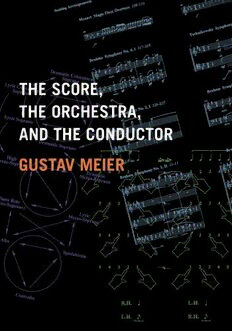
The Score, the Orchestra, and the Conductor PDF
Preview The Score, the Orchestra, and the Conductor
The Score, the Orchestra, and the Conductor The Score, the Orchestra, and the Conductor GUSTAV MEIER 1 2009 1 Oxford University Press, Inc., publishes works that further Oxford University’s objective of excellence in research, scholarship, and education. Oxford New York Auckland Cape Town Dar es Salaam Hong Kong Karachi Kuala Lumpur Madrid Melbourne Mexico City Nairobi New Delhi Shanghai Taipei Toronto With offices in Argentina Austria Brazil Chile Czech Republic France Greece Guatemala Hungary Italy Japan Poland Portugal Singapore South Korea Switzerland Thailand Turkey Ukraine Vietnam Copyright © 2009 by Gustav Meier Published by Oxford University Press, Inc. 198 Madison Avenue, New York, New York 10016 www.oup.com Oxford is a registered trademark of Oxford University Press. All rights reserved. No part of this publication may be reproduced, stored in a retrieval system, or transmitted, in any form or by any means, electronic, mechanical, photocopying, recording, or otherwise, without the prior permission of Oxford University Press. Library of Congress Cataloging-in-Publication Data Meier, Gustav, 1929– The score, the orchestra, and the conductor / Gustav Meier. p. cm. Includes bibliographical references and index. ISBN 978-0-19-532635-2; 978-0-19-532636-9 (pbk.) 1. Conducting. 2. Orchestral music—Interpretation (Phrasing, dynamics, etc.) I. Title. MT85.M337 2009 781.45—dc22 2008027044 9 8 7 6 5 4 3 2 1 Printed in the United States of America on acid-free paper for emy With love and appreciation I dedicate this book to Emy, my wife and best friend, who made it possible for the book to become a reality. This page intentionally left blank contents Introduction 3 chapter 1 The Beat 5 Introduction 5 A. Basic Techniques 6 1. The Baton 6 2. Placement of the Beat 6 3. The Size of the Beat 6 4. A System for Notating Beats 7 B. The Preparatory Beat 8 Introduction 8 1. Response to the Preparatory Beat 9 2. Influence of Orchestration on the Preparatory Beat 10 3. Preparatory Beat to Count 1 (without Setting Tempo) 15 4. Preparatory Beat to Count 1 (Setting Tempo): The Rebound 17 5. Beat Patterns 18 6. Preparatory Beat to Counts Other Than 1 19 7. Preparatory Beat to Upbeats 21 C. Types of Beats 26 1. Standard Beat 26 2. Staccato Beat 27 3. Legato Beat 29 4. Nonrebound Beat 30 5. Neutral Beat 31 6. Circular Beat 32 D. Other Preparatory Beats 33 1. Multiple Preparatory Beats 33 2. The Added Nondurational Preparatory Beat 35 3. No Preparatory Beat for Solo Entrances 36 E. Irregular Meters 37 1. Description of the Patterns 37 2. Preparatory Beat to Count 1 39 viii Contents 3. Preparatory Beat to Other Counts 43 4. Preparatory Beat to Upbeats 43 F. Subdivision 44 1. Full Subdivision 44 2. Modified Subdivision 45 G. Ritardando and Accelerando 46 1. Definition 46 2. Subdivision in Ritardandos 47 3. Compounding Beats in Accelerandos 47 H. Bars to Be Conducted in One 48 1. Individual Bars 48 2. Groups of Bars 50 I. Subito Tempo and Dynamic Changes 53 1. Subito Tempo Changes from Slow to Fast at the Same Dynamic Level 53 2. Subito Tempo Changes from Fast to Slow at the Same Dynamic Level 54 3. Combination Fast to Slow, Slow to Slower, and Slow to Fast 54 ff (cid:3) 4. Subito Dynamic Changes from to 55 (cid:3) ff 5. Subito Dynamic Changes from to 56 (cid:4)z (cid:5)(cid:3) 6. and 58 7. Successive Preparatory Beats 58 8. Splitting a Single Preparatory Beat 59 J. Beat Options 61 1. Choosing the Beat Unit 61 2. Some Metrical Problems 61 a. Hemiola and Rebarring 61 b. Other Conflicting Patterns and Rebeaming 65 c. Polyrhythmic Sections 66 3. Suppressing the Rebound 67 4. Dictating 68 5. Cutoffs and Exits 71 6. The Luftpause 72 7. Fermatas 74 8. Tied Notes 81 9. Syncopations 82 10. Tacet Bars and Grand Pauses 84 11. Sudden Silences and Their Continuation 86 12. Stopping the Beat 88 13. To Conduct or Not to Conduct 88 14. Composite Rhythmic Textures 89 Contents ix chapter 2 Reading the Score 97 A. Notation 97 B. Rhythm and Tempo 98 C. Metronome Markings 100 D. The Common Denominator 105 E. Dynamics 128 F. Phrasing and Articulation 129 chapter 3 Preparation of the Score for Conducting 131 A. Analysis 131 B. Reading Through the Orchestral Part of Each Instrument 131 C. Notation Issues 133 D. Cuing 142 E. Security 147 F. Marking the Score for Irregular Meters 149 chapter 4 Seating Arrangements: Symbols for a Cuing System 151 A. General and Historical Information 151 B. The String Section 152 C. The Woodwind Section 153 D. The Brass Section 154 E. The Percussion Section, Harp, Piano, and Celesta 155 F. Symbols and Positions 156 1. The String Section 156 2. The Woodwind Section 159 3. The Brass Section 165 G. Using Numbers Instead of Symbols to Indicate the Order of Entrances 169 1. The String Section 170 2. The Woodwind Section 192 3. The Brass Section 206 H. Combined Traffic Patterns 208 chapter 5 Sorting the Orchestration 223 chapter 6 The Zigzag Way 243 A. Leading the Orchestra 243 B. The Zigzag Way 257 1. Beethoven, Symphony no. 2, First Movement— Adagio molto 258
